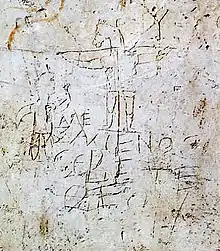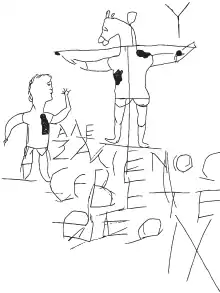Alexamenos graffito
The Alexamenos graffito (also known as the graffito blasfemo, or blasphemous graffito)[1]:393 is a piece of Roman graffito scratched in plaster on the wall of a room near the Palatine Hill in Rome, which has now been removed and is in the Palatine Museum.[2] It may be meant to depict Jesus; if so, it competes with an engraved gem as the earliest known pictorial representation of the Crucifixion of Jesus.[3] It is hard to date, but has been estimated to have been made c. 200.[4] The image seems to show a young man worshipping a crucified, donkey-headed figure. The Greek inscription approximately translates to "Alexamenos worships [his] god,"[5] indicating that the graffito was apparently meant to mock a Christian named Alexamenos.[6]

Content

The image depicts a human-like figure affixed to a cross and possessing the head of a donkey or mule. In the top right of the image is what has been interpreted as either the Greek letter upsilon or a tau cross.[1] To the left of the image is a young man – apparently intended to represent Alexamenos[7] – as a Roman soldier or guard, raising one hand in a gesture possibly suggesting worship.[8][9] The name Alexamenos (and its Latinate variant Alexamenus) is only attested in this instance, being composed of the common Greek compound elements of ἀλέξω (alexo, "I defend, help") and μένος (menos, "strength, bravery, power, etc.").[10] Beneath the cross is a caption written in crude Greek: ΑΛΕ ξΑΜΕΝΟϹ ϹΕΒΕΤΕ ϑΕΟΝ, ALE XAMENOS. ϹΕΒΕΤΕ can be understood as a variant spelling (possibly a phonetic misspelling)[2] of Standard Greek ϹΕΒΕΤΑΙ, which means "worships".[lower-alpha 1] The full inscription would then be read as Ᾰλεξᾰ́μενος σέβεται θεόν, "Alexamenos worships [his] God".[2][11][12] Several other sources suggest "Alexamenos worshiping a god", or similar variants, as the intended translation.[13][14][15][16] In the next chamber, another inscription in a different hand reads ΑΛΕξΑΜΕΝΟϹ FIDELIS (Alexamenos fidelis), Latin for "Alexamenos is faithful" or "Alexamenos the faithful".[17] This may be a retort by an unknown party to the mockery of Alexamenos represented in the graffito.[18]
Date
No clear consensus has been reached on when the image was made. Dates ranging from the late 1st to the late 3rd century have been suggested,[19] with the beginning of the 3rd century thought to be the most likely.[11][20][18]
Discovery and location
The graffito was discovered in 1857 when a building called the domus Gelotiana was unearthed on the Palatine Hill. The emperor Caligula had acquired the house for the imperial palace, which, after Caligula died, became used as a Paedagogium (boarding school) for imperial page boys. Later, the street on which the house sat was walled off to give support to extensions to the buildings above, and it thus remained sealed for centuries.[21]
Interpretation
The inscription is usually taken to be a mocking depiction of a Christian in the act of worship.[22] At the time, pagans derided Christians for worshipping a man who had been crucified.[22] The donkey's head and crucifixion would both have been considered insulting depictions by contemporary Roman society. Crucifixion continued to be used as an execution method for the worst criminals until its abolition by the emperor Constantine in the 4th century, and the impact of seeing a figure on a cross is comparable to the impact today of portraying a man with a hangman's noose around his neck or seated in an electric chair.[23] Already Paul the Apostle wrote that "Christ crucified [was] foolishness to Gentiles" (1 Corinthians 1:23).
It seems to have been commonly believed at the time that Christians practiced onolatry (donkey-worship). That was based on the misconception that Jews worshipped a god in the form of a donkey, a claim made by Apion (30-20 BC – c. AD 45-48):[24] Tertullian writes:
Origen reports in his treatise Contra Celsum that the pagan philosopher Celsus made the same claim against Christians and Jews:[25]
Tertullian, writing in the late 2nd or early 3rd century, reports that Christians, along with Jews, were accused of worshipping such a deity. He also mentions an apostate Jew who carried around Carthage a caricature of a Christian with ass's ears and hooves, labeled Deus Christianorum ὀνοκοίτης[26] ("The God of the Christians conceived of an ass.").[27]
It has also been suggested that both the graffito and the roughly contemporary gems with Crucifixion images are related to heretical groups outside the Church.[28]
The most common interpretation is that this graffito depicts Jesus of Nazareth.[29] However, Hudson MacLean considers the image can either depict Jesus or Anubis.[12] Other searchers considers that the graffito represents either "probably a scene of Gnostic worship, representing the Egyptian God Anubis", or that the crucified being was the god Set or Typhon-Set.[29]
In the image, Alexamenos is portrayed venerating an image of the crucifix, a detail that Peter Maser believed to represent actual Christian practice of veneration of icons. This practice, however, was not known to be a part of Christian worship until the 4th or 5th century.[11]
Notes
- More specifically, ϹΕΒΕΤΑΙ/σέβεται is the third-person present-tense singular indicative middle/passive conjugation for σέβομαι (see Ancient Greek grammar and Koine Greek grammar), which classically means, "to feel awe or fear before God, especially when doing something disgraceful". It also carries a more general meaning of feeling shame or religious awe. Its descendant in Modern Greek, σέβομαι, merely means, "respect".
References
- Bayley, Harold (1920). Archaic England: An essay in deciphering prehistory from megalithic monuments, earthworks, customs, coins, place-names, and faerie superstitions. Chapman & Hall. p. 393. Archived from the original on 2015-02-01. Retrieved 2020-02-28.
alexamenos.
- Rodney J. Decker, The Alexamenos Graffito Archived 2015-01-02 at the Wayback Machine
- Schiller, 89-90, fig. 321
- "Alexamenos and pagan perceptions of Christians". uchicago.edu.
- Squire, Michael (22 December 2015). Sight and the Ancient Senses. ISBN 9781317515388. Retrieved 2018-08-31.
- Viladesau, Richard (1992). The Word in and Out of Season. Paulist Press. p. 46. ISBN 0-8091-3626-0. Retrieved 2016-07-19.
- Rodolfo Lanciani, Ancient Rome in the Light of Recent Discoveries, 1898, chapter 5 'The Palace of the Caesars'
- Thomas Wright, Frederick William Fairholt, A History of Caricature and Grotesque in Literature and Art, Chatto and Windus, 1875, p. 39
- Hare, Augustus John Cuthbert (2005). Walks in Rome, Volume 1. Adamant Media Corporation. p. 201. ISBN 9781402186424.
- "Behind the Name - Alexamenos". Archived from the original on 2019-05-23. Retrieved 2019-05-23.
- Balch, David L.; Osiek, Carolyn (2003). Early Christian Families in Context: An Interdisciplinary Dialogue. Wm. B. Eerdmans Publishing. p. 103. ISBN 9780802839862.
- MacLean, B. Hudson (2002). An introduction to Greek epigraphy of the Hellenistic and Roman periods from Alexander the Great down to the reign of Constantine. University of Michigan Press. p. 208. ISBN 0472112384.
- Hassett, Maurice M. (1907). . In Herbermann, Charles (ed.). Catholic Encyclopedia. 1. New York: Robert Appleton Company.
- "Home Page – Concordia Theological Seminary". Ctsfw.edu. Archived from the original on 2008-07-04. Retrieved 2012-10-17.
- "A Sociological Analysis of Graffiti" (PDF). Sustain.ubc.ca. Archived from the original (PDF) on 2011-10-04. Retrieved 2012-10-17.
- Charles William King (1887). "Gnostics and their Remains". p. 433 note 12. Archived from the original on 2012-11-04. Retrieved 2012-10-17.
- Hassett, Maurice M. (1909). . In Herbermann, Charles (ed.). Catholic Encyclopedia. 6. New York: Robert Appleton Company.
- Green, Michael (2004). Evangelism in the Early Church. Wm. B. Eerdmans Publishing. p. 244. ISBN 9780802827685.
- Schwarz, Hans (1998). Christology. Wm. B. Eerdmans Publishing. p. 207. ISBN 9780802844637.
- Schiller, 90
- Cutts, Edward L (2004). History of Early Christian Art. Kessinger Publishing. p. 200. ISBN 9780766187214.
- Drum, Walter (1910). . In Herbermann, Charles (ed.). Catholic Encyclopedia. 7. New York: Robert Appleton Company.
- Wright, N. T. (1997). What Saint Paul Really Said: Was Paul of Tarsus the Real Founder of Christianity?. Wm. B. Eerdmans Publishing. p. 46. ISBN 9780802844453.
- from Against Apion book II, 7, written by Josephus.
- BOOK VII CHAP. XL.
- "Tertulliani Apologeticum". Archived from the original on 2018-09-12. Retrieved 2018-08-31.
- Tertullian, Apologeticum, 16, 1 and 12. Archived 2017-01-05 at the Wayback Machine
- Schiller, 89-90
- Young, Thomas R. (2015-01-07). "The Alexamenos Graffito and Its Rhetorical Contribution to Anti-Christian Polemic". Rochester, NY: 12–13. doi:10.2139/ssrn.2546438 – via SSRN. Cite journal requires
|journal=(help)
Sources
- Schiller, Gertrud. Iconography of Christian Art, Vol. II,1972 (English trans from German), Lund Humphries, London, ISBN 0-85331-324-5
Further reading
- Titus Flavius Josephus, Against Apion, II (VII), 2.80
- Norman Walker, The Riddle of the Ass's Head, and the question of a trigram, ZAW 9 (1963), 219–231.
External links
| Wikimedia Commons has media related to Alexamenos graffito. |